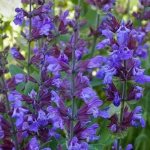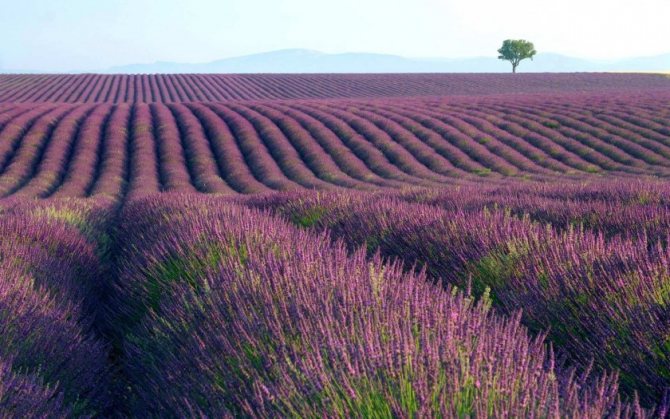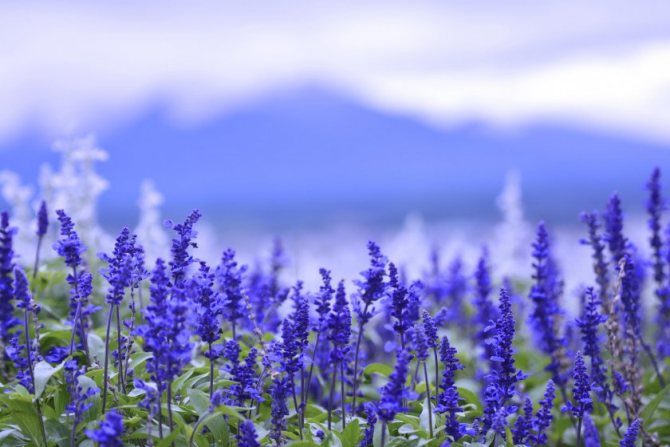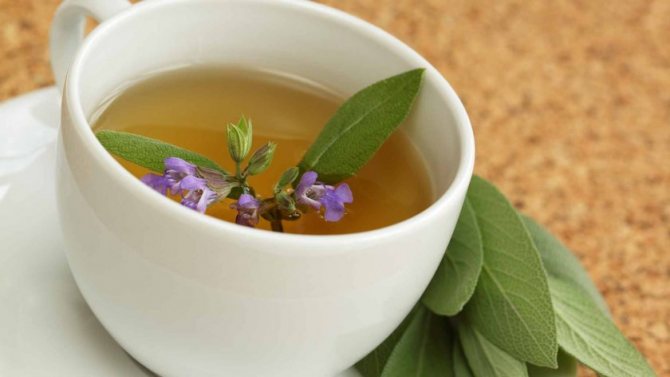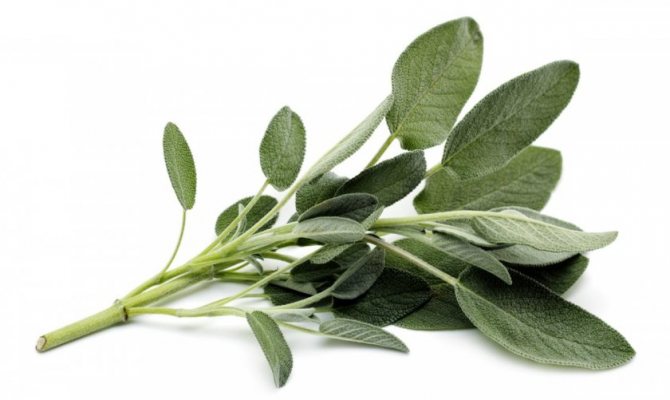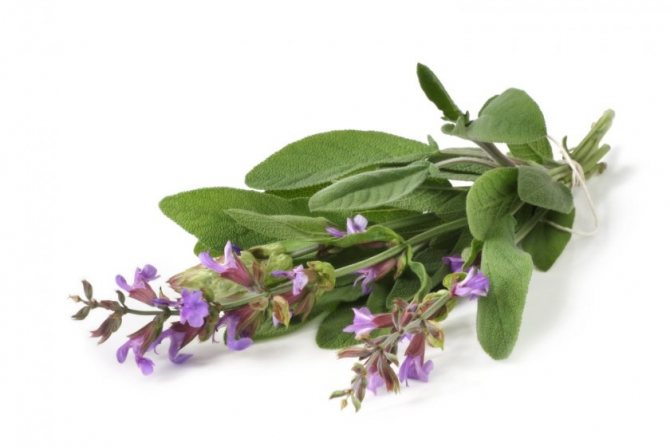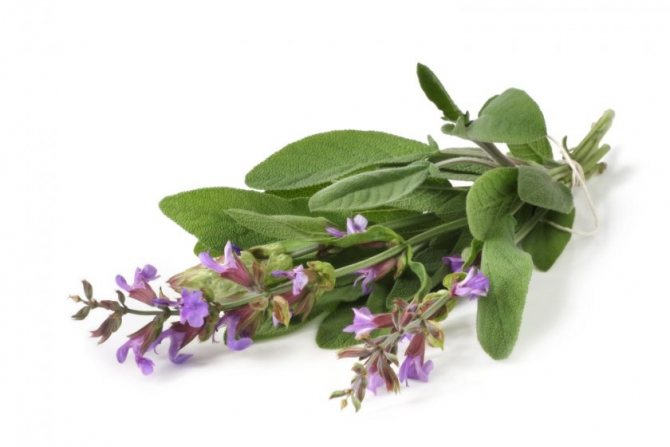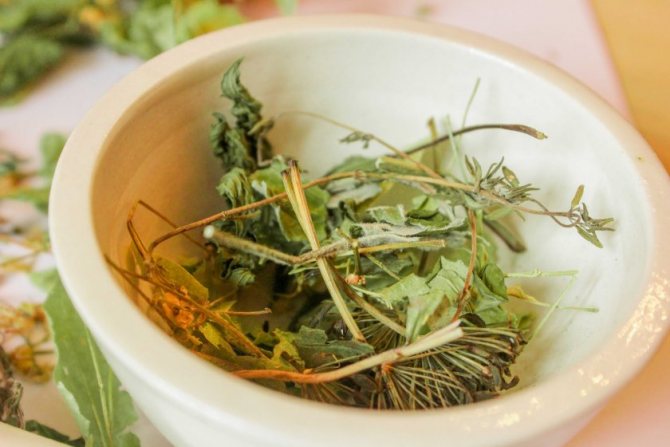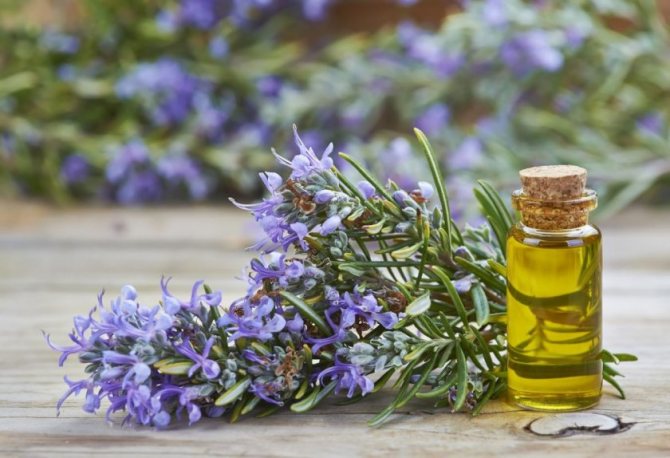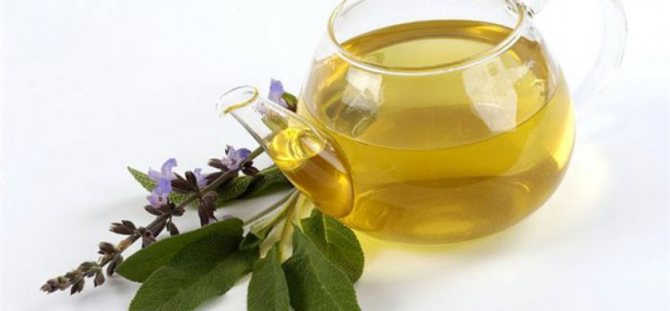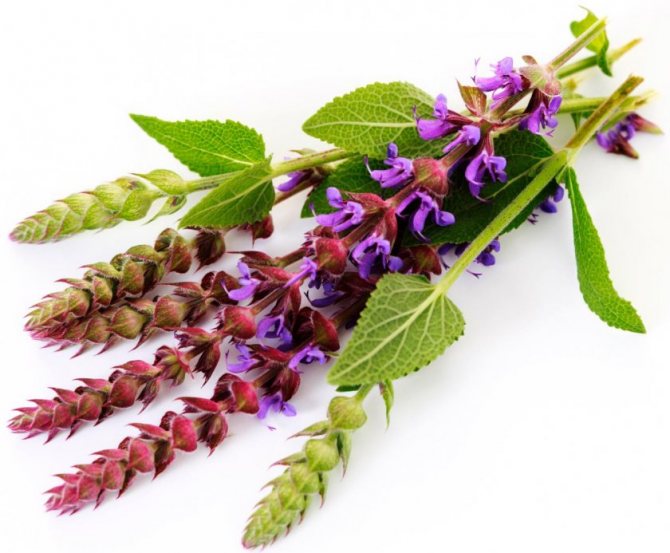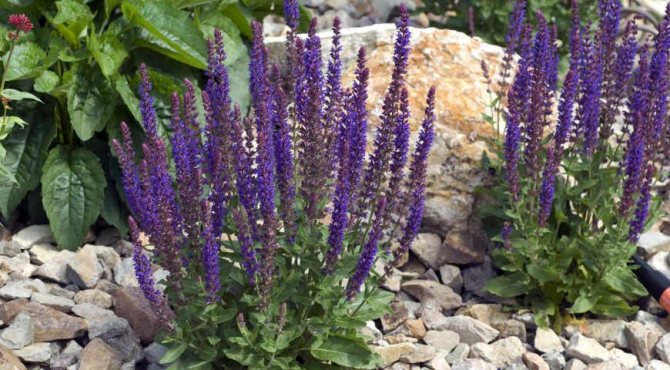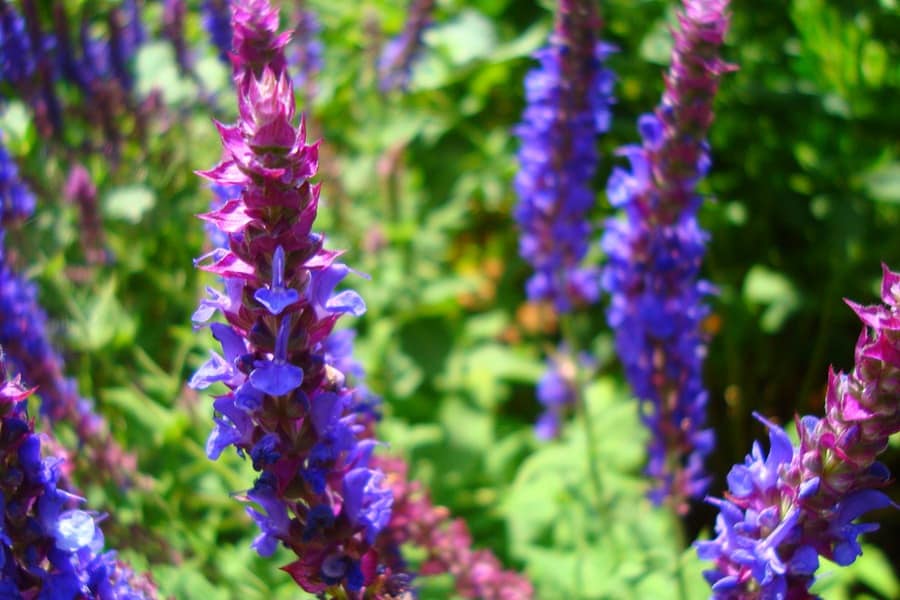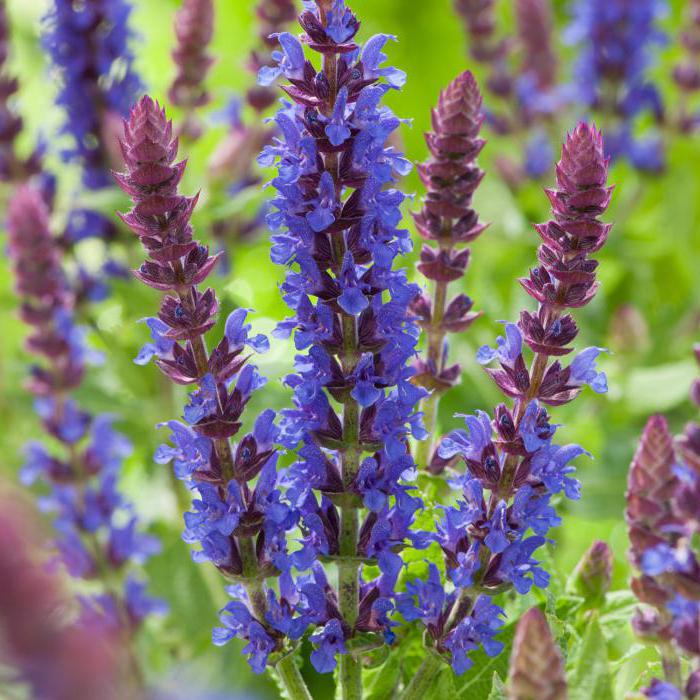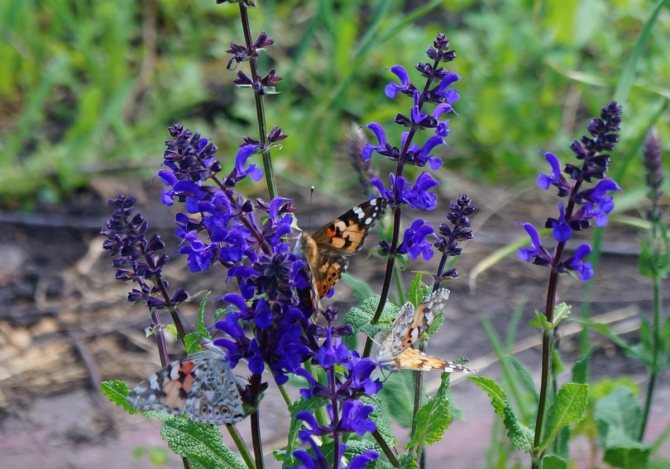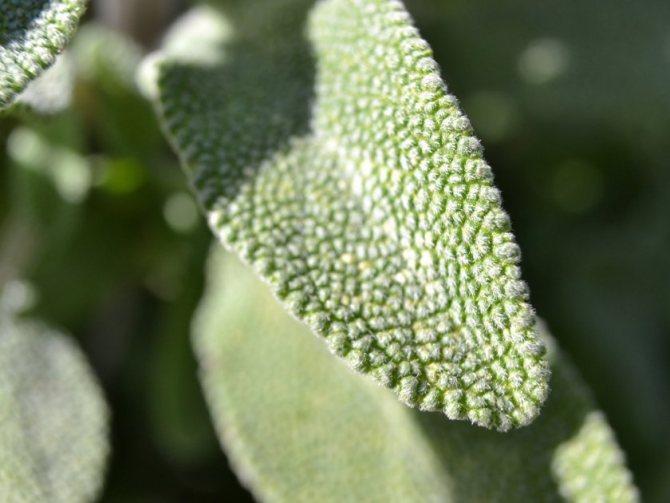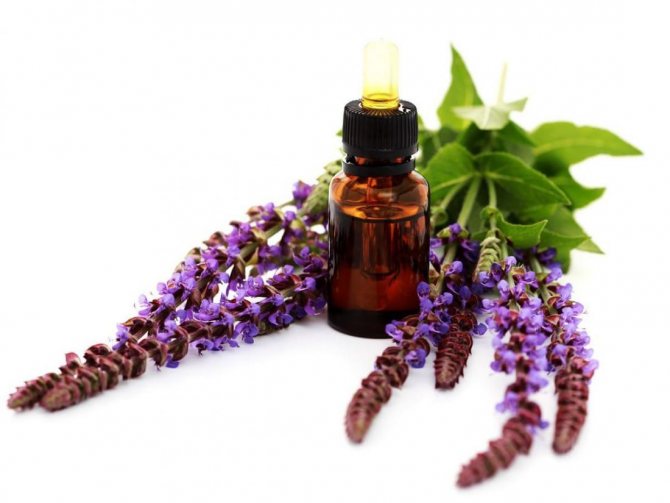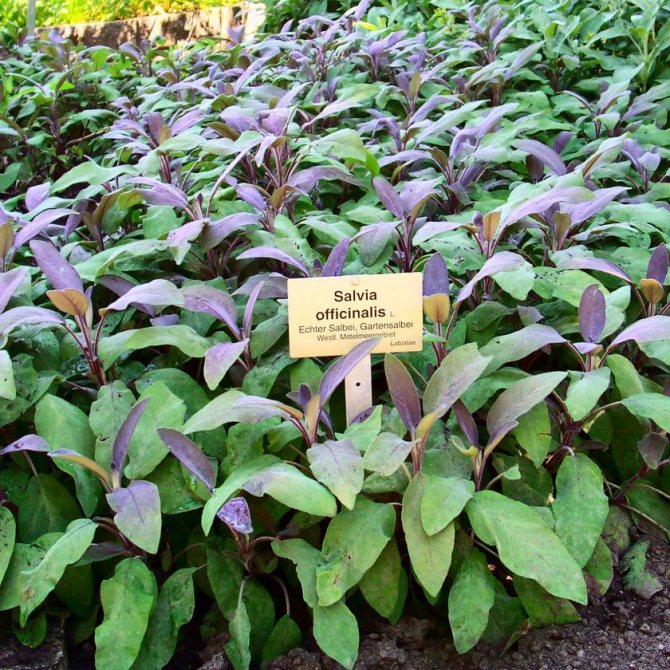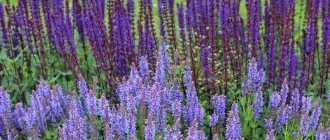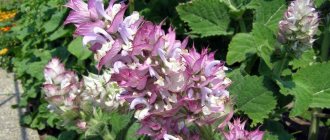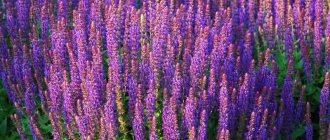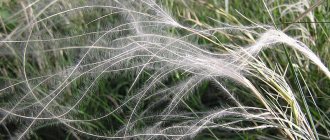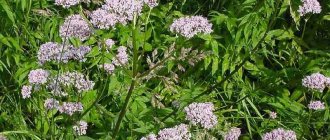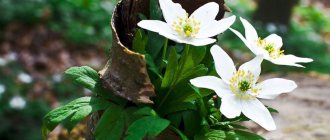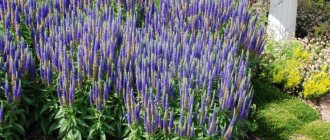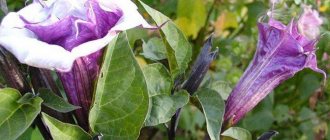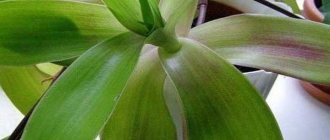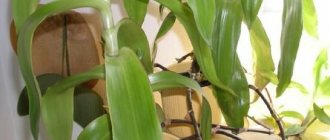Sage medicinal is a beautiful scented shrub popular with bees and often underestimated as a flowering garden plant. It was most likely used in ancient Egypt to treat stomach ailments, toothaches, and asthma. It was mentioned in the Ebers papyrus (1500 BC) as an anti-itch remedy. Hippocrates' followers praised its hemostatic and strengthening qualities, as well as its beneficial effects during menstruation.
Shrub description
The second name for sage is salvia, which is translated from Latin as “to be healthy”. Therefore, it is used by pharmaceutical companies for the production of medicinal products. The most common types of sage are:
- Medicinal sage is a bush up to 70 cm high. Leaves are gray-green, narrow, elongated. The stem is densely covered with whitish villi. Used in medicine, cooking, cosmetology. There are several varieties, the most common: Breeze, Nectar, Aibolit, Semko Patriarch.
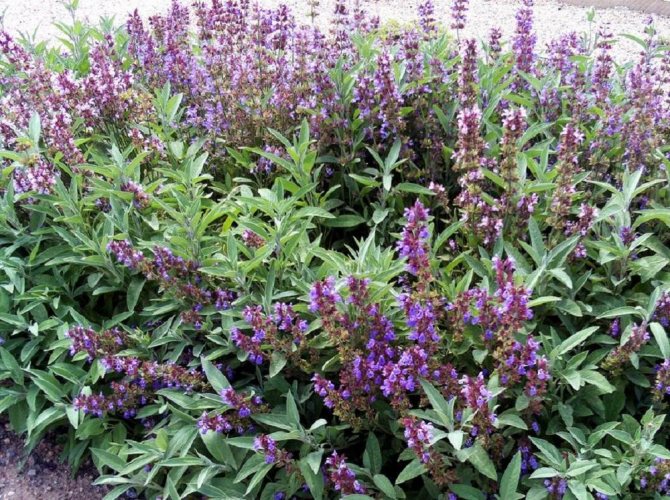
Salvia officinalis
- Sage (oak) grows in nature on the edges of forests and on the slopes of hills. It is a spicy herb with a herbaceous stem and lanceolate leaves. Inflorescences of a purple or blue hue are spike-shaped. In turn, it is subdivided into low-growing varieties: their inflorescences bloom with blue, purple, purple flowers (for example, Blue Queen forest salvia) and tall, spike-shaped inflorescences of which have a wider palette of colors: from white and pink to blue and purple (for example, Caradonna sage ).
- Clary sage is a type of forest sage. The leaves have an unusual color: yellow-green, for which it is also popular in ornamental gardening.
Note! In folk medicine, salvia leaves are brewed, the infusion helps with colds, as well as for its prevention.
Oak sage belongs to the Yasnotkovye family. The height of this herbaceous shrub varies from 30 to 90 cm, its leaves are 3.5 to 10 cm long and 1.5 to 3 cm wide. At the bottom, the stem becomes lignified over time, above it remains herbaceous. In winter, the top can freeze out, but in spring the plant quickly recovers.
Flowers are collected in whorls, which are located along the stem at a distance of 1.5 cm. It blooms all summer, fruits in the form of triangular-spherical nuts are formed in August-September.
How to use salvia officinalis
On the basis of medicinal raw materials, infusions, decoctions, extracts and tinctures are prepared for ingestion and external use. Water-based products are used to treat diseases of the gastrointestinal tract, respiratory system, diabetes mellitus, gynecological and dental diseases. They also effectively relieve puffiness and normalize the work of the sweat glands.
Alcohol-containing herbal preparations are used externally in the form of lotions and rubbing. They effectively cope with diseases of the musculoskeletal system, skin diseases, purulent wounds, bruises and bruises. Read more in the article - sage extract.
Sage has been used in cosmetology due to its nourishing, tonic and strengthening properties. Plant-based products are used to care for problem skin and hair. Read more in the article - sage for women.
The plant is widely used in cooking and dietetics. Sage is used to season the first and second courses, it is used in preservation and for making drinks.
You can often find recipes for dietary dishes with sage for weight loss. The plant normalizes metabolic processes in the body, removes excess fluid and promotes the destruction of fat cells.
Throat decoction (for cough)
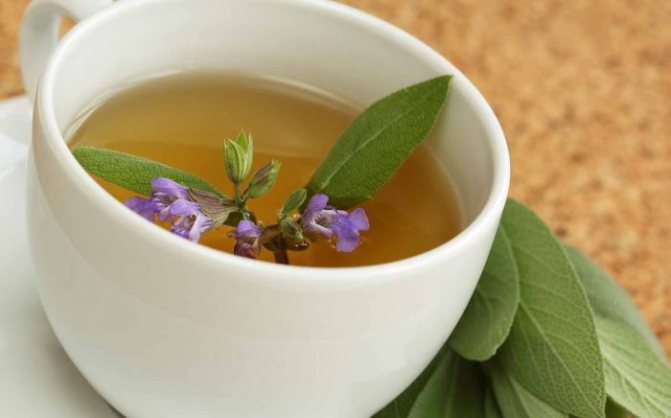

Broth is the most common form of sage preparations. A decoction of sage is effective for angina, pharyngitis, laryngitis. The tool is used as a rinse or inside. Read more in the article - sage broth.
Ingredients:
- Sage leaves - 1 tablespoon
- Water - 200 ml.
How to cook: Cover sage leaves with water, place in a water bath and bring to a boil over medium heat. Place a lid on the container, reduce heat to low, and simmer for 15 minutes. Remove the broth from the stove, wrap the pan with a towel and leave to infuse for another half hour. Strain the cooled liquid through a cotton-gauze filter.
How to use: Gargle with the resulting broth 5-6 times a day. One glass of drink is needed for one procedure. This remedy can be used for inhalation with sage. It is added to hot water or a nebulizer at the rate of 1 tablespoon per 100 ml of saline.
Result: Sage decoction effectively relieves inflammation, eliminates pain and sore throat. When taken orally, the agent has an antitussive effect.
Interesting: Medicinal properties and contraindications of oak bark, how to apply
Tincture for conception
Sage is useful for women's health, so products based on it are widely used in gynecology. A decoction of the plant is used for douching, as it effectively normalizes the vaginal microflora. Read more in the article - sage in gynecology.
Sage tea and alcohol-containing tinctures are taken orally to treat infertility. So the water infusion of the plant is suitable for longer use and has a weak therapeutic effect. Vodka tincture is taken strictly in courses not longer than 1 month and only after consultation with a specialist. Read more in the article - sage tincture.
Ingredients:
- Sage roots - 30 gr.
- Vodka - 500 ml.
How to cook: Cut the sage roots into pieces, put the medicinal raw material in a glass jar and fill with vodka. Close the container with a lid, shake the bottle and store in a dark place at room temperature. Insist the remedy for a week. Strain the finished tincture through multilayer cheesecloth.
How to use: Take 1 tablespoon on an empty stomach with 100 ml of boiled water. The course of admission is 1 month. If it is necessary to extend the treatment, take a break for 2 months and repeat the course.
Result: The product normalizes hormones and blood circulation in the pelvic organs. With a course admission, the chances of conceiving a child are significantly increased.
Infusion in cosmetology (for hair, for face)
The infusion of the plant is widely used in cosmetology. It is added to ready-made skin care creams and lotions, or used neat as a tonic. Sage is beneficial for the face due to its ability to nourish and tighten the skin, eliminate inflammation and accelerate cell regeneration. Consider a tonic recipe.
Ingredients:
- Sage leaves - 1 tablespoon
- Water - 250 ml.
How to cook: Chop the sage leaves, put them in a thermos and pour boiling water over them. Insist the product under a tightly closed lid for 2 hours. Filter the finished infusion through multilayer gauze.
How to use: Dip a cotton pad in the infusion, wring it out and pat your face with blotting movements. The procedure is carried out twice a day - in the morning and before bedtime.
Result: Effectively cleanses and tones the skin.With systematic use, age-related changes in the epidermis go away, the skin acquires a healthy appearance.
Sage is also used in cosmetology for hair care. The tool is used in its pure form as a rinse or it is added to ready-made shampoos. Read more in the article - sage for hair.
Ingredients:
- Sage leaves - 2 tablespoons
- Water - 500 ml.
How to cook: Add water to chopped sage leaves, bring mixture to a boil over medium heat and remove immediately from heat. Cover the container with a lid and let the product steep for 3 hours. Pass the cooled liquid through a cotton-gauze filter.
How to use: Rinse hair washed with shampoo, wrap it with a towel and leave the product for 15-20 minutes, then rinse with warm water infusion.
Result: Sage infusion strengthens hair follicles, eliminates dandruff and itchy scalp. With regular use, it has a coloring effect, therefore, on light curls, it should be applied no more than 1-2 times during a week.
Acne oil
Sage oil is good for problem skin. The tool has a pronounced anti-inflammatory and disinfectant effect. The product is used pointwise to cauterize acne.
Ingredients:
- Sage leaves - 10 gr.
- Vegetable oil - 50 ml.
How to cook: Grind the sage leaves in a coffee grinder to a powder consistency. Heat the oil to a temperature of 37-38 degrees, pour it into the powder and mix thoroughly until smooth. Insist the product for 8-10 hours in the refrigerator in a tightly closed container.
How to use: Cauterize inflammation with the oil obtained twice a day - in the morning and in the evening. The product does not require rinsing.
Result: Sage oil effectively removes inflammation and redness, accelerates epidermis healing and prevents the formation of scars and marks on the skin.
Sweating baths
Baths with a decoction of sage for sweating are taken to normalize the work of the sebaceous glands. The product effectively regulates their work, reduces skin oiliness and has a deodorizing effect.
Interesting: Properties of rosemary, how to apply, contraindications
Ingredients:
- Sage leaves - 5 tablespoons
- Water - 1 liter.
How to cook: Grind the leaves of the plant, pour boiling water over them and place the container on the stove. Bring the product to a boil and simmer over medium heat for half an hour. Remove the pot from the stove, cover and warm with a towel. Infuse the drink for 2 hours, then strain the liquid through a fine sieve covered with gauze.
How to use: Pour the resulting infusion into the bath, dilute it with warm water. Carry out the water treatment for 15-20 minutes.
Result: The product effectively reduces perspiration and normalizes the sebaceous glands. Sage infusion baths eliminate unpleasant odors by killing the pathogenic microbes that cause it.
You have learned how to brew sage for making medicines. Now we will tell you if the plant can be used while waiting for the baby.
Can salvia officinalis during pregnancy
Sage-based products are contraindicated at any stage of pregnancy. This prohibition is associated with the abortive activity of the plant. The drugs increase the tone of the uterus and can provoke a miscarriage in the first weeks of gestation or premature birth in late pregnancy.
During the waiting period for the child, only external use of sage-based products is allowed. Infusions and decoctions of the plant are used to treat wounds and abrasions, as well as for cosmetic purposes.
You found out if you can drink sage during pregnancy. Now we list the main contraindications to the use of herbal remedies.
Growing
Sage of diviners - what kind of plant, description, where it grows
In order for Salvia Dubravnaya to take root well and grow quickly, she needs to find a good place in the garden. Bushes grow quickly, so they should not be planted too close to each other. The distance to the next plant depends on its size, on average, planting is carried out according to the scheme: 50 × 50 or 60 × 60 cm.
Important! Sage has an inherent ability to cross-pollinate, so it is better to plant varieties in different parts of the garden.
The landing site is well-lit and warmed up by the sun. It is recommended to cover sage for the winter, as it is a heat-loving plant. The culture is drought-resistant, waterlogging is dangerous for it. In regions with frosty winters, it is grown as an annual plant.
The soil
Oak sage does not make great demands on the soil. The most important condition is that groundwater should not lie too close to the surface. For growing salvia, both a potting soil mixture for indoor plants and ordinary garden soil are suitable.
In the fall, the soil is prepared for spring planting: a plot is dug up, flavored with humus and phosphorus-potassium fertilizers. The acidity of the soil should be normal.
Note! Excessive fertilization of the soil will lead to the fact that the green part of the bush will develop well, and the flowers will be small and expressionless.
Reproduction
It is produced in several ways: by seeds, cuttings, dividing the bush, air layering. Which of the methods to use, the gardener decides for himself after studying the characteristics of each of them.


Cuttings
Through seedlings
Brachikoma - description, planting and care
Seeds can be sown directly into the ground in spring or autumn, or by pre-growing seedlings. The second method is used more often, since when sown directly into the ground, sage grows slowly. Sowing for seedlings usually begins at the end of winter.
Drainage is laid at the bottom of the tank, for example, expanded clay. Then light, loose soil pours out. Seeds are sown on top, sprinkled with earth a little and slightly moistened. To keep moisture in the soil for a long time, you can use a hydrogel. It is soaked in water, in which it soon swells, and is mixed with the soil.
Important! Since the seeds of oak sage are small, they should not be sprinkled too much: they may not sprout under a thick layer of soil. From above, the container is covered with glass or plastic wrap.
After the appearance of the fourth leaf, the seedlings dive into separate pots. Before the beginning of summer, the seedlings have time to get stronger. After about 2.5 months, the seedlings can be planted in open ground, having previously hardened them. To do this, in April they are taken out for several hours a day.
At first, it should be a shady place, then gradually you can accustom the seedlings to the direct rays of the sun. Also, several sage bushes can be left in pots for growing on windowsills, creating favorable conditions for them.
Seed in open ground
Sage is planted in this way in early spring or late autumn. Here's how to do it:
- the soil is dug up, leveled with a rake, sprinkled with calcined sand, on which the seeds are laid;
- sand is sprinkled on top, the bed is moistened and covered with a film;
- the planting is periodically ventilated, but at the same time you need to make sure that the garden bed always remains moist.
After about 3 weeks, the sprouts will hatch. After 3-4 leaves appear, the film is removed.
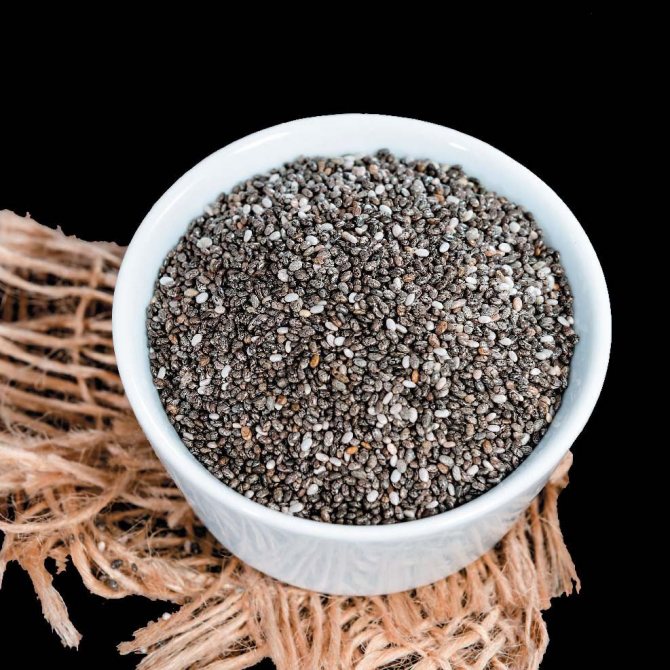

Sage seeds
Cuttings
To do this, the shoot is cut with a sharp knife just below the knot about 10 cm long and placed in a glass of water. After 2-3 weeks, roots are formed, visible through the glass. When they reach a length of 2 cm, the shoot is planted in a pot. The land should not be too nutritious.
At first, the plant is provided with increased moisture.To do this, the cutting is covered with a glass jar or plastic wrap, but the leaves should not touch the surface of the covering material. The greenhouse must be periodically ventilated so that the cuttings do not catch a fungal disease.
Important! The optimum room temperature is 20 ° C. When the seedlings have taken root, they can be planted in larger pots for indoor use or in open ground. After a month, sage can be fed with a weakly concentrated solution of fertilizer for flower plants.
Planting pots should be deep because the root system of the salvia is well-branched. The stems of the bushes are flexible, the outermost ones spread along the ground, so they need a support. Or, in this case, you can apply another method of plant breeding.
Reproduction by layering
When the shoot comes into contact with damp ground, roots form at the nodes of the plant. Therefore, if the gardener wants to get sage shoots, he needs to ensure that the soil in the place of contact with the stem is always moist. Also, for reliability, the shoot can be pinned to the ground with something and lightly sprinkled.
Dividing the bush
This method is used in the southern regions. The division of the plant is done at the end of summer. Sage is gently undermined, the root is divided into parts. Delenka must have a root system and at least one stem. Each excavated process is planted in a separate planting hole.


Dividing the bush
Plant care
Dwarf dahlias - description, planting and care
It consists in timely weeding, watering, fertilization, plant pruning, protection from diseases and pests.
Watering and loosening
Irrigation must be timely. In this case, watering should not be abundant. The procedure is performed in the morning or evening. When watering at noon, the sun's rays can burn the delicate leaves, and this will negatively affect the plant as a whole.
Loosening is also a necessary procedure. After it, moisture remains in the ground, oxygen is available to the roots. In addition, weeds are removed at the same time, taking away nutrients from the plant.
Fertilizer
Every spring, you need to feed the bushes. First, nitrogen fertilizers are used to build up green mass. Then, 1 time in 3 weeks, liquid fertilizing is applied, for example, an aqueous solution of manure (1:10) or an infusion of weeds of the same concentration. Mineral fertilizers are used in the fall.
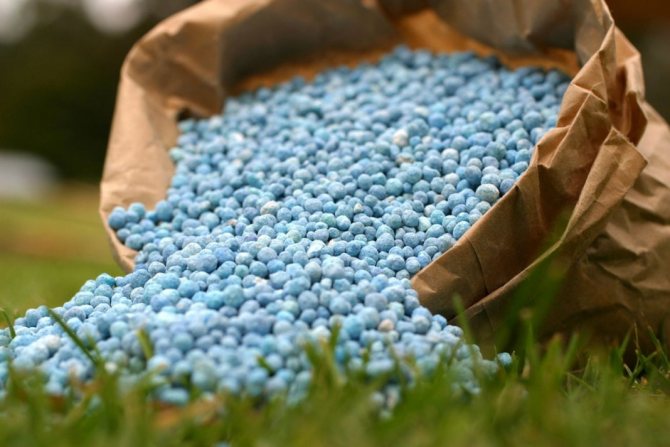

Nitrogen fertilizers
Pruning
This is an important procedure for the beautiful shaping of the bush. If not produced, the sage will stretch out and age quickly. Pruning will provoke the awakening and growth of the lateral buds. As a result, the bush will intensively grow new shoots.
Important! Shrubs are cut in spring and autumn. Dry spikelets are also pruned after flowering. This procedure can induce the plant to bloom again. Dry, broken branches are also removed.
Diseases and pests
Sage is a spicy, medicinal plant that can independently fight various diseases. Therefore, it is little susceptible to various misfortunes. Improper care can be the reason for the poor condition of the bush.
- Mold can form with excessive moisture. Therefore, water stagnation in the soil should not be allowed. At the first appearance of mold, the plant is sprayed with a sulfur solution.
- Slugs and spider mites can appear in too dense plantings. Onion and garlic tincture is used as a control method. Laundry soap is added to the infusion so that the solution adheres well to the greens.
Important! Considering that sage is used in cooking and traditional medicine, it is impossible to use chemical agents to combat diseases and pests.
We grow at home
As a perennial plant, medicinal sage can be grown at home. Sage will delight you for five years.The rest of the sage species are annuals and will have to be planted once a year. To grow sage at home, some rules are required:
- Watering the plant should be regular, but not daily.
- It is important not to allow the soil to dry out or overflow.
- If garden soil is used for planting the plant, clean it as much as possible from roots and visible debris.
- For sowing, you can take a simple plastic cup, when you reach a larger size, you need to transplant the plant into a wider container.
- Take a light shower once a week or wipe the leaves with a damp cloth.
- House sage is afraid of drafts, try not to allow this.
The growth of sage at home is not difficult, with proper watering, its maintenance will not be difficult.
In order for the plant to bloom profusely, the shoots should be cut off in time, about once every two months.
Sage is light-loving and frost-hardy; you can place it on a balcony or terrace. For the winter, place the plant in a dark place with high humidity.
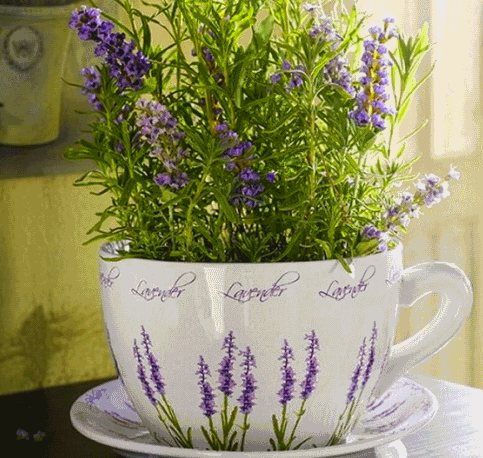

Photo of an annual plant in a pot
Harvesting
It is produced in summer and autumn. The first time is at the end of June during blooming of inflorescences. It was at this time that sage contained the greatest amount of essential oils required for use in cooking, cosmetology and for medicinal purposes.
The plant is mowed almost to the roots along with flowers and stems. At the end of September, an autumn collection of medicinal herbs is held. By this time, greenery appears again on the bushes, which grows violently after the previous pruning. Harvesting is done in dry weather.
Healing properties
The medicinal raw material of sage has a pronounced anti-inflammatory, disinfectant, astringent, diuretic and hemostatic effect.... Funds based on it are used internally and applied externally.
The benefits of sage for the body lie in the rich chemical composition of the plant. Decoctions and infusions are taken for colds. The funds effectively eliminate sore throat and relieve the symptoms of acute respiratory viral infections, acute respiratory infections, tonsillitis and laryngitis.
The plant is useful for coughing. It effectively removes phlegm and eliminates sore throat. Read more in the article - sage cough.
Among the indications for the use of sage leaves are diseases of the gastrointestinal tract. Herbal drinks normalize digestion, eliminate inflammation and have an analgesic effect on gastritis, ulcers and colitis.
Plant-based products have a beneficial effect on the cardiovascular and nervous systems. They regulate the work of the heart, soothe, normalize sleep and increase efficiency. Contraindicated in case of sudden pressure surges.
Herbal remedies are widely used for diseases of the oral cavity. Sage is effective for toothache. Infusions and decoctions are used for rinsing. They effectively eliminate inflammation, heal mucosal ulcers and freshen breath.
Interesting: Three-leaf watch - medicinal properties, contraindications, use
The beneficial properties of sage are often used in gynecology. Douching with decoctions is effective in treating inflammatory diseases. Taking drugs inside normalizes hormonal levels, promotes conception and eliminates the symptoms of menopause. Read more in the article - sage with menopause.
Herbal remedies are no less useful for the stronger sex. They normalize blood circulation in the pelvic organs and increase sexual activity. Read more in the article - sage for men.
Outwardly, sage is used for cosmetic purposes. Plant-based products are added to creams, ointments, shampoos, balms and masks. They have a nourishing, strengthening and regenerating effect. These products are used for skin and hair care.
Varieties of varieties
Breeders have bred many varieties of oak sage. The most famous of them are:
- Sage Ostfritsland (Ostfritsland). Branched stems are about 40 cm long, leaves are slightly shriveled. Blooms all summer with purple and blue-violet flowers.
- Mainacht is a taller bush. Its inflorescences are purple, the leaves are oblong. Blooms several times per season.
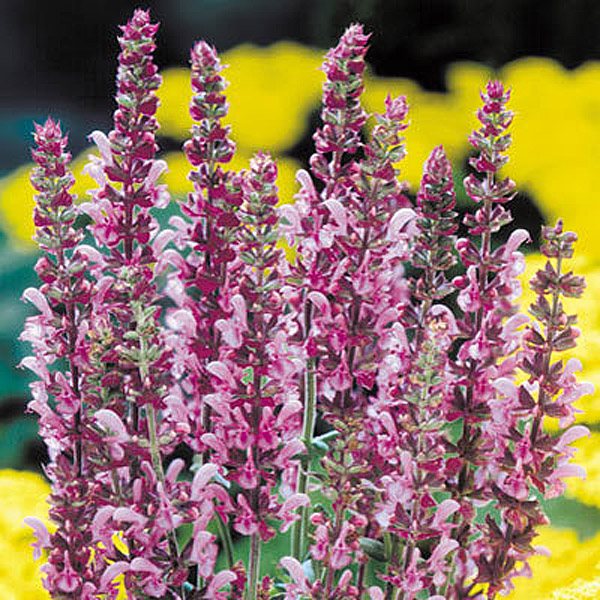

Sage - Schwellenburg differs from other varieties in purple and red inflorescences. It is widely used in gardens for decoration.
- Forest sage Ametist is a dense bush with dense candles of pink-purple inflorescences. After flowering, the bush remains neat, retains its shape.
- Forest sage Blauhugel is one of the unpretentious and cold-resistant shrubs. It has fragrant gray-green leaves, purple inflorescences. Blooms profusely in June and July.
- Oak sage Caradonna. The height of the bush is 70-80 cm, the inflorescences are lilac, the leaves are gray-green. Blooms from early summer until frost.
In addition to those listed, there are many more varieties of oak sage, suitable for decorating a garden plot and characterized by a long flowering period.
Oak sage shrub and its properties
Sage belongs to perennial flowering low shrubs. However, its value is not so much in its attractive appearance as in its pronounced medicinal properties (Figure 1).


Figure 1. Sage is a valuable ornamental and medicinal plant
It is noteworthy that all sage varieties are used in landscape design, regardless of the shade of the flowers. In medicine, almost all parts of the plant are used, from roots to inflorescences. But it is important that medicinal raw materials should be harvested in the morning in dry weather and before flowering. If the collection and harvesting were performed correctly, the plant retains its beneficial properties for two years.
Salvia has a lot of healing properties. First of all, it calms the nervous system well and relieves stress, but it can also be used for bactericidal and anti-inflammatory purposes.
Use in landscape design
Many gardeners plant oak sage to decorate the garden. Its spikelets of blue-violet color are beautifully combined with plants that have warm shades of buds: orange, yellow, red.
Important! Sage is not recommended to be planted after related plants of the Lamiaceae family.
The description of the sage Caradonna deserves special attention. It has strong vertical stems, covered with gray-green leaves, and amazingly beautiful purple inflorescences. This variety always keeps vertical, never falls apart. Combines with lavender, sedums, gray fescue, echinacea.
Sage is planted in the foreground or next to roses, lilies. In the alpine hills, it coexists with hyacinths, tulips, irises. By planting them with decorative cereals, the gardener will receive a landscape design in a rural style. Also, bushes are used to form a hedge.
Due to the wide area of application of oak sage, unpretentious care, this green space is one of the most common in garden plots, as well as terraces of houses and balconies of apartments.

